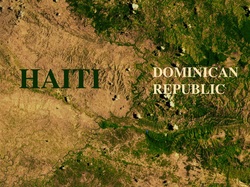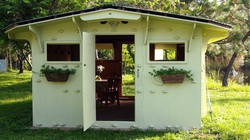
Disaster Shelter | Haiti Economic Conditions, Part 1 of 5
After several trips to Haiti after creating my disaster shelter, Shelter In A Day, the thing that stands out about Haiti's economic conditions are the lack of jobs. Sadly, no matter where you go in Haiti, there are always plenty of people around who obviously need something better to do. It was in Haiti that I first heard the word ‘funemployment’ which means that you have work you are doing but there is no paycheck involved.
After several trips to Haiti after creating my disaster shelter, Shelter In A Day, the thing that stands out about Haiti's economic conditions are the lack of jobs. Sadly, no matter where you go in Haiti, there are always plenty of people around who obviously need something better to do. It was in Haiti that I first heard the word ‘funemployment’ which means that you have work you are doing but there is no paycheck involved.

I met and talked to people all over the country and there are several impressions that worked their way into my mind: First, The Haitian people, as a whole, are the happiest and friendliest people I have ever encountered in my travels. Second, they love to be busy and if there is no work, they will stay busy somehow (funemployment). Third, they have a deep respect for education as the way forward for their people.

The dysfunctional politics of Haiti can be mostly blamed on the economic conditions that prevail. There is not enough economic activity in general and almost no exports in particular. This results in a small tax base and chronically underfunded government. This was made far worse when most government buildings were destroyed by the earthquake. The overall economic conditions can be blamed on many things but from my perspective, much of the fault can be attributed to the fact that Haiti and the Haitian people have always been victims of their odd geography. The Island of Hispaniola which contains both Haiti and the Dominican Republic (DR) is situated in the tropical trade-winds. Haiti is downwind (west) of the DR and ringed with mountains along its windward borders. The moisture laden, northeast (winter) and southeast (summer) trade winds are forced upwards by the mountains on the DR side. This causes them to drop their moisture on the way up. The result is that most rainfall occurs in the DR making that country relatively lush and Haiti gets what rainfall is left, which isn’t enough to support the population agriculturally without irrigation. This rainfall difference is dramatic when seen from the air. The border is starkly delineated by greenery on the DR side and bare ground on the other, and deforestation is spreading, compounding the misery of the Haitian people.
You might ask where is this going? What can be done? To find out more check back next week for Part 2 in our 5 part series - Disaster Shelter | Haiti Economic Conditions.
READERS: What are some suggestions you might offer?
You might ask where is this going? What can be done? To find out more check back next week for Part 2 in our 5 part series - Disaster Shelter | Haiti Economic Conditions.
READERS: What are some suggestions you might offer?

About Shelter In A Day | Disaster Shelters
Shelter In A Day is the brainchild of eco-friendly, furniture designer Frank Schooley. Shelter's disaster recovery housing provides safe and secure, simple to construct, green homes for those displaced by natural disasters, such as hurricanes, earthquakes or floods.
The disaster shelters are a solidly constructed, termite, rust and rot resistant house, with lockable doors and windows. Homes are crafted from waterproof, recycled wood fiber material and can be easily erected anywhere, in one day.
Shelter In A Day is the brainchild of eco-friendly, furniture designer Frank Schooley. Shelter's disaster recovery housing provides safe and secure, simple to construct, green homes for those displaced by natural disasters, such as hurricanes, earthquakes or floods.
The disaster shelters are a solidly constructed, termite, rust and rot resistant house, with lockable doors and windows. Homes are crafted from waterproof, recycled wood fiber material and can be easily erected anywhere, in one day.
| | |
